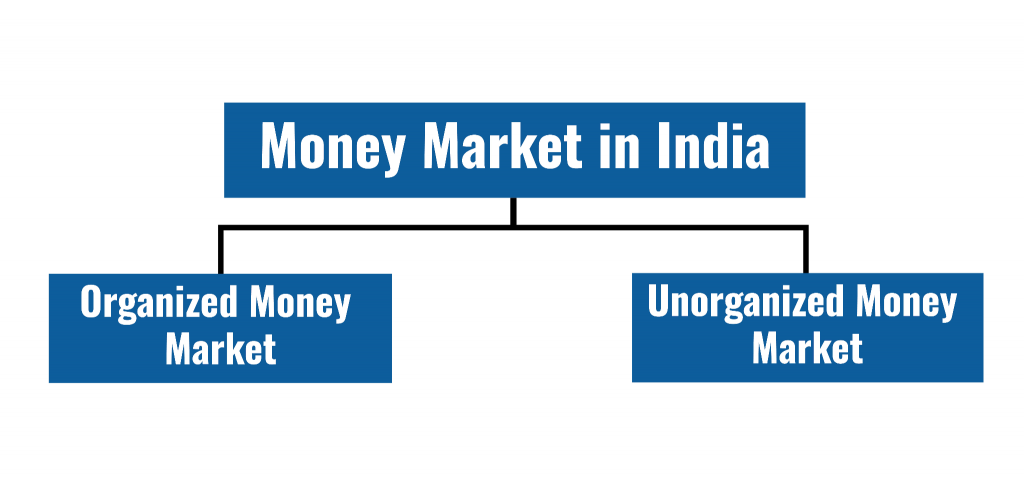The Money Market, as a crucial segment of the financial market, is integral for managing liquidity and funding short-term obligations for banks, governments, and corporations. Understanding its dynamics is essential for developing a grasp of the Indian Financial System. This article of NEXT IAS aims to study in detail the Money Market, including its meaning, structure, major instruments, roles, and other related concepts.

What is Money Market?
- Money Market refers to that part of the broader Financial Market in which highly liquid and short-term financial assets with maturity upto 1 year are traded.
- Thus, it caters to the short-term borrowing needs of working capital.
- Because of the short maturity period, it offers high liquidity of securities, and hence money market investments are also called cash investments.
| – Financial Market is a broad term, referring to any center or arrangement where buyers and sellers participate in the trade of financial claims such as equities, bonds, currencies, and derivatives. – The Financial Market is classified into two categories. a. Money Market– Market for trading short-term financial assets with a maturity of upto 1 year b. Capital Market – Market for borrowing and lending of medium and long-term funds, above 1 year. |
Structure of Indian Money Market
Broadly speaking, the money market in India comprises two sectors.

Organized Money Market
- This sector of the money market in India is characterized by registration, approval, and license from market regulators.
- It is called organized because it is systematically coordinated by the RBI and other market regulators.
- Major participants in the Organized Money Market in India include – the RBI, Banks, NBFCs, Mutual Funds, Insurance Companies, etc.
Unorganized Money Market
- This sector of the money market in India refers to the one that is not registered and not regulated.
- It is called unorganized because it is not systematically coordinated by the RBI or any other market regulator.
- Major participants in the Unorganized Money Market in India include – Local Moneylenders, Chit Funds, etc.
Major Instruments of Money Market
Various types of Money Market Instruments are used in India, each catering to specific needs and participants. Some of the major instruments of Money Market in India are discussed in detail in the sections that follow.
Call Money or Money at Call
- Call Money refers to inter-bank borrowing and lending for a very short period, typically overnight to upto 14 days.
- The Call Money or Money at Call enables banks and financial institutions to manage their short-term liquidity requirements.
- The rate at which money is borrowed in these markets is called the Call Money Rate.
- The Call Money Rate keeps changing on an hourly basis, depending on the demand and supply.
- Call Money Market has 2 segments:
Call Market or Overnight Market
It refers to the market for borrowing and lending of money between banks for 1 day.
Short Notice Market
It refers to the market for borrowing and lending of money between banks for upto 14 days.
Treasury Bills (T-Bills)
- Treasury Bills or T-Bills refer to short-term securities issued by the RBI on behalf of the Central Government.
- They act as short-term fundraising tools for the government.
- Treasury Bills (T-Bills) are one of the two types of Government Securities (G-Secs).
- One other type of Government Securities (G-Secs) is Government Bonds, which have a maturity period of more than 1 year and hence are Capital Market instruments.
Features of Treasury Bills (T-Bills)
- Treasury bills are issued at a discount to the original value and the buyer gets the original value upon maturity.
- For example, a Rs 100 treasury bill can be availed of at Rs 95, but the buyer is paid Rs 100 on the maturity date. This is called redemption at par or face value.
- Thus, they are non-interest bearing i.e. 0 coupon or 0 interest, and hence are also called 0 coupon bonds.
- Being backed by the Government, these bills are considered risk-free and are highly liquid.
- These bills are issued only by the Central Government (through the RBI).
- The State Governments do not issue T-Bills.
- Instead of direct selling, T-Bills are auctioned in the market, wherein each buyers submit their bids and the bill is sold to the buyer willing to pay the highest price.
- The option of bidding ensures the highest revenue for the government as well as transparency in the issuing process.
- T-Bills are available for a minimum amount of ₹ 25,000 or in multiples of ₹ 25,000.
- As of now, there are 3 types of T-Bills auctioned by the RBI:
- 91-day T-Bills – Have a maturity period of 91 days.
- 182-day T-Bills – Have a maturity period of 182 days.
- 364-day T-Bills – Have a maturity period of 364 days.
- T-Bills can be used by the Banks for:
- Keeping as part of their SLR requirements.
- Providing as collateral to the RBI for getting loans under Repo.
Cash Management Bills (CMBs)
- Similar to T-Bills, CMBs are also short-term securities sold by the RBI on behalf of the Central Government, but with a maturity period of less than 91 days.
- It is also aimed at meeting the short-term cash flow mismatches of the Government of India.
- Similar to T-Bills, CMBs are also issued at a discount to the face value through auctions by the RBI.
- Banks are allowed to keep CMBs to meet their SLR requirements.
Ways and Means Advances (WMAs)
- Way and Means Advances (WMAs) are temporary loans or overdraft facilities extended by the RBI to the Governments.
- This facility is available to both Central Government as well as State Governments.
- WMA was introduced as per an agreement between the RBI and the Government of India under Section 17(5) of the RBI Act.
- They replaced the Ad-hoc T-Bills, which were earlier used by the Government to meet short-term expenditure for a particular purpose.
- WMAs are not considered as a source of finance for the government. Rather, they are aimed to bridge the time interval of mismatch between the government’s expenditures and expected receipts.
- If the government avails immediate cash from the RBI under normal WMA, it has to return the amount within 90 days. In case the WMA repayment surpasses 90 days, it is treated as an overdraft.
- For the normal WMA, the rate of interest charged by the RBI is the Repo Rate. For the overdraft, the rate of interest is (Repo Rate + 2%).
Certificate of Deposit (CD)
- Certificate of Deposit (CD) is a security issued by the Scheduled Commercial Banks (SCBs) and some other Financial Institutions (FIs) that have been permitted by the RBI to raise short-term funds.
- Note: Cooperative Banks and Regional Rural Banks (RRBs) are not allowed to issue Certificates of Deposit (CDs).
- Certificates of Deposit (CDs) should be issued in multiples of ₹1 lakh, with a minimum amount of ₹1 lakh.
- They are issued at a discount on face value and are redeemed at par or face value.
- Their maturity period is, usually, more than 7 days and less than 1 year.
- Withdrawal of a CD before the maturity date results in a penalty.
- Banks are not allowed to provide loans against the CDs.
Commercial Paper (CP)
- Commercial Paper (CP) is a type of unsecured, short-term debt instrument issued by large Corporations, Primary Dealers, and Financial Institutions (FIs).
- The eligible institutions may issue Commercial Papers (CPs) to finance their short-term needs, such as inventory management, meeting payroll expenses, funding new projects, etc.
- A Commercial Paper is issued as an unsecured promissory note and is placed privately.
- They should be issued in multiples of ₹5 lakh, with a minimum amount of ₹5 lakh.
- Their maturity period is a minimum of 7 days and a maximum of upto 1 year.
Commercial Bill (CB) or Trade Bill
- Commercial Bill (CB) is a negotiable instrument drawn by the seller or buyer of goods/services for the value of goods/services delivered.
- Commercial Bills (CBs) act as a way for a seller (drawer) to extend credit to a buyer (drawee) for goods or services purchased.
- When a Commercial Bill gets accepted by a Commercial Bank, it is called as Trade Bill.
- Note: A Commercial Bill or Trade Bill is discounted by the Commercial Bank first. The Bank, then, gets it re-discounted by the RBI.
Importance of Money Market
- It provides a mechanism for managing liquidity. Banks and other financial institutions use various instruments of money market to balance their short-term surplus and deficits, ensuring cash availability is aligned with their operational needs.
- It enables the growth of businesses and industries by allowing them to finance their short-term capital requirements and expenses without dipping into long-term funding resources, which may be costlier and less flexible.
- It plays a crucial role in financing both internal as well as international trade.
- It reflects short-term interest rates, offering insights into the broader economy’s health.
- Interest rates in the money market serve as benchmark rates for the economy. The rates for various instruments in this market form the basis for pricing loans, mortgages, and other types of credit in broader financial markets.
In conclusion, the Money Market plays a pivotal role, serving as a mechanism for the efficient management of liquidity and short-term funding needs for individuals, businesses, and governments. Its critical role in ensuring financial stability means that it is crucial for the smooth functioning of the financial system.
Related Concepts
Promissory Note
A Promissory Note is a legal document that serves as a written promise by the issuer to repay a certain sum of money to another party (the payee) under specific terms and conditions.
Government Securities (G-Secs)
- A Government Security or G-Sec refers to a tradable instrument issued by the Central Government or the State Government.
- Being backed by the government, these securities are considered risk-free.
- G-Secs are, mainly, of 2 types.
Treasure Bills (T-Bills)
- These are short-term Government Securities (G-Secs), with a maturity period of less than 1 year.
- Thus, they are a Money Market instrument and not a Capital Market instrument.
- In India, only the Central Government can issue Treasury Bills (T-Bills).
- State Governments are not empowered to issue Treasury Bills (T-Bills).
Government Bonds or Dated Government Securities or Gilt-Edged Securities
- These are long-term Government Securities (G-Secs), with a maturity of more than 1 year.
- Thus, they are a Capital Market instrument and not a Money Market instrument.
- In India, both the Central Government and the State Governments can issue Government Bonds.









